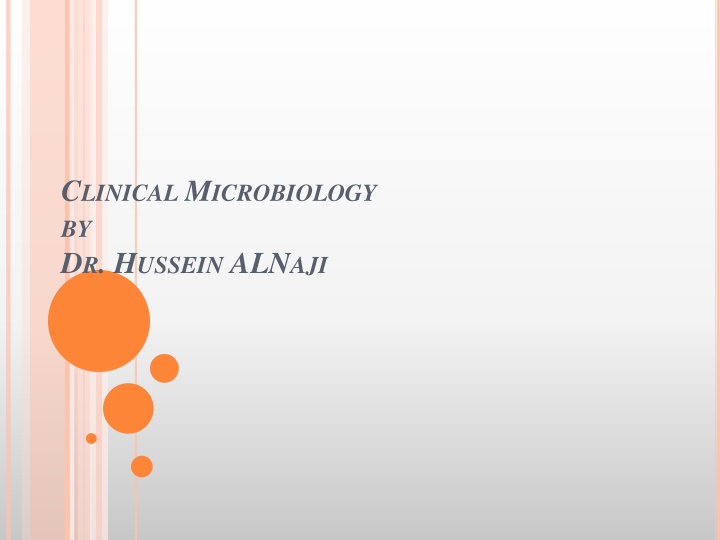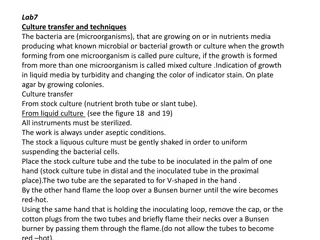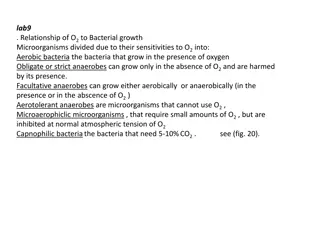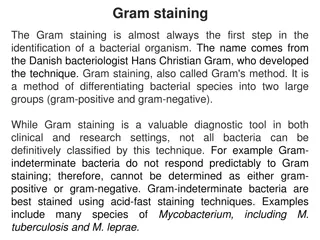Importance of Bacterial Culturing in Diagnosis and Study
Culturing bacteria in vitro serves a crucial role in diagnosing infectious diseases and understanding bacterial morphology. It involves selecting appropriate culture media based on suspected bacteria, ensuring optimal atmospheric conditions, temperature, and growth requirements. Bacteria can be categorized based on their oxygen needs, from facultative anaerobes to strict aerobes. Understanding these growth conditions is essential for successful culturing. Different bacteria have varied growth requirements, necessitating the use of specific culture media. Solid media, containing agar, are commonly used for bacterial isolation and colony characterization in microbiology laboratories.
Download Presentation

Please find below an Image/Link to download the presentation.
The content on the website is provided AS IS for your information and personal use only. It may not be sold, licensed, or shared on other websites without obtaining consent from the author.If you encounter any issues during the download, it is possible that the publisher has removed the file from their server.
You are allowed to download the files provided on this website for personal or commercial use, subject to the condition that they are used lawfully. All files are the property of their respective owners.
The content on the website is provided AS IS for your information and personal use only. It may not be sold, licensed, or shared on other websites without obtaining consent from the author.
E N D
Presentation Transcript
CLINICAL MICROBIOLOGY BY DR. HUSSEIN ALNAJI
One of the most important reasons for culturing bacteria in vitro is its utility in diagnosing infectious diseases. Isolating a bacterium from sites in body normally known to be sterile is an indication of its role in the disease process. Culturing bacteria is also the initial step in studying its morphology and its identification. The specimens received in the laboratory are plated on the culture media. The appropriate culture media is selected depending upon the bacteria suspected. The following precautions need to be taken into consideration when the culture methods are processed
1- Optimal atmospheric conditions 2- Optimal temperature 3- Growth requirement of the bacteria Atmospheric conditions: Colonies of bacteria are usually large enough to identify after 18 24 hours of incubation (usually at 37 C), but for some bacteria longer incubation times are required (from 2 days to several weeks). Microorganisms can be grouped on the basis of their need for oxygen to grow.
Facultative anaerobic bacteria can grow in high oxygen or low oxygen content and are among the more versatile bacteria. strictly anaerobic bacteria grow only in conditions where there is minimal or no oxygen present in the environment. Bacteria such as bacteroides found in the large bowel are examples of anaerobes. Strict aerobes only grow in the presence of significant quantities of oxygen. Pseudomonas aeruginosa, an opportunistic pathogen, is an example of a strict aerobe. Microaerophilic bacteria grow under conditions of reduced oxygen and sometimes also require increased levels of carbon dioxide. Neisseria species (e.g., the cause of gonorrhea) are examples of micraerophilic bacteria
Temperature: Most of the bacteria requires a temperature of 37 C for optimal growth. This temperature is provided placing the inoculated culture plates in the incubator set at 37 C temperature. Growth requirement of the bacteria Different bacteria have different growth requirements. For eg Streptococcuspneumoniae requires factor V and factor X for its growth, which are found in chocolate agar. Thus for sample suspected of S. pneumoniae the samples are plated on chocolate agar. Similarly depending upon the growth requirements the appropriate culture media are used.
Classification of culture media used in Microbiology laboratory On the basis of consistency Solid medium . solid medium contains agar at a concentration of 1.5-2.0% or some other. Solid medium is useful for isolating bacteria or for determining the colony characteristics of the isolate. Semisolid media . They are prepared with agar at concentrations of 0.5% or less. They have soft custard like consistency and are useful for the cultivation of microaerophilic bacteria or for determination of bacterial motility. Liquid (Broth) medium . Broth medium serves various purposes such as propagation of large number of organisms, fermentation studies, and various other tests. e.g. sugar fermentation tests.
Classification of culture media based on the basis of composition Synthetic or chemically defined medium . A chemically defined medium is one prepared from purified ingredients and therefore whose exact composition is known. Non synthetic or chemically undefined medium Non-synthetic medium contains at least one component that is neither purified nor completely characterized nor even completely consistent from batch to batch. Often these are partially digested proteins from various organism sources. Nutrient broth, for example, is derived from cultures of yeasts.
Classification of Bacterial Culture Media based on the basis of purpose/ functional use/ application General purpose media/ Basic media . Basal media are basically simple media that supports most non- fastidious bacteria. Peptone water, nutrient broth and nutrient agar are considered as basal medium. These media are generally used for the primary isolation of microorganisms. Enriched medium (Added growth factors) Addition of extra nutrients in the form of blood, serum, egg yolk etc, to basal medium makes them enriched media. Enriched media are used to grow nutritionally exacting (fastidious) bacteria. Blood agar, chocolate agar.
Selective and enrichment media. They are designed to inhibit unwanted commensal or contaminating bacteria and help to recover pathogen from a mixture of bacteria. Various approaches to make a medium selective include addition of antibiotics, dyes, chemicals, alteration of pH or a combination of these. Example MacConkey sAgar used for Enterobacteriaceae members contains bile salt that inhibits most gram positive bacteria. Differential/ indicator medium: differential appearance: Certain media are designed in such a way that different bacteria can be recognized on the basis of their colony colour. Such as Blood agar (various kinds of hemolysis i.e. , and hemolysis).
Transport media : Clinical specimens must be transported to the laboratory immediately after collection to prevent overgrowth of contaminating organisms or commensals. Anaerobic media : Anaerobic bacteria need special media for growth because they need low oxygen content, reduced oxidation reduction potential and extra nutrients. Assay media . These media are used for the assay of vitamins, amino acids and antibiotics. E.g. antibiotic assay media are used for determining antibiotic potency by the microbiological assay technique.
Blood agar, hemolysis, and hemolytic reactions Blood agar is a solid growth medium that contains red blood cells. The medium is used to detect bacteria that produce enzymes to break apart the blood cells. This process is also termed hemolysis. The degree to which the blood cells are hemolyzed is used to distinguish bacteria from one another. There are three types of hemolysis, designated alpha, beta and gamma. Alpha hemolysis is a greenish discoloration that surrounds a bacterial colony growing on the agar. This type of hemolysis represents a partial decomposition of the hemoglobin of the red blood cells. Alpha hemolysis is characteristic of Streptococcus pneumonia.
Beta hemolysis represents a complete breakdown of the hemoglobin of the red blood cells in the vicinity of a bacterial colony. There is a clearing of the agar around a colony. Beta hemolysis is characteristic of Streptococcus pyogenes and some strains ofStaphylococcus aureus. Gamma hemolysis is a lack of hemolysis in the area around a bacterial colony. A blood agar plate displaying gamma hemolysis actually appears brownish. This is a normal reaction of the blood to the growth conditions used (37 C in the presence of carbon dioxide).























